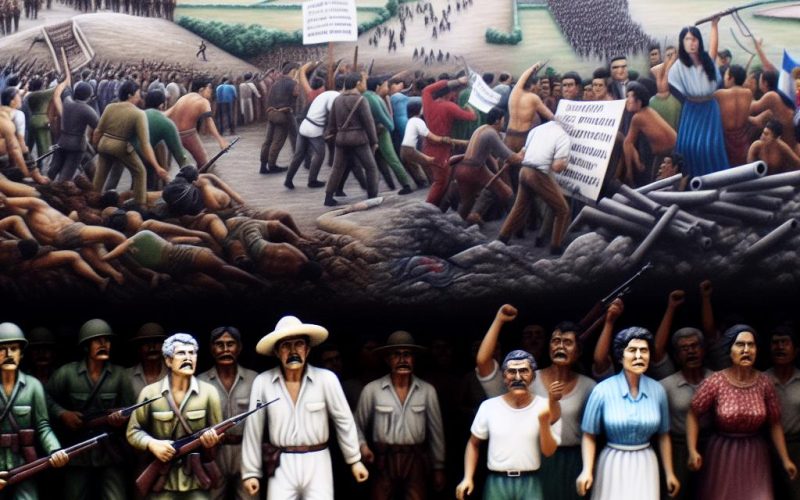Overview of the Civil Wars in Guatemala and El Salvador
Guatemala and El Salvador witnessed profound civil wars that were pivotal not only in terms of their extensive durations and intensities but also in the way they redefined the political trajectories of these nations. Rooted in socioeconomic discrepancies, political marginalization, and the overarching Cold War dynamics that shaded Latin America throughout the 20th century, these wars left indelible marks on their respective countries.
Guatemala Civil War (1960-1996)
The civil strife in Guatemala persisted for 36 tumultuous years, making it one of Latin America’s lengthiest and bloodiest conflicts. This war was ignited by a dramatic political shift following the U.S.-endorsed coup of 1954, which displaced President Jacobo Árbenz, catalyzing a prolonged period of military governance and widespread suppression.
Causes of the Conflict
The roots of the Guatemalan Civil War lie in severe economic imbalances, systemic marginalization of indigenous communities, and entrenched political oppression. Successive military administrations, often marked by authoritarian governance, enjoyed substantial backing from the United States. During the Cold War, the U.S. perceived leftist ideologies as a pressing threat, further intensifying the military’s grip on power.
Key Events
The war’s timeline is marred by numerous human rights atrocities, notably the scorched earth campaigns, which were particularly brutal against civilian populations, with indigenous Maya communities often bearing the brunt of the violence.
Resolution
1996 saw the cessation of hostilities with the signing of the Accords of Firm and Lasting Peace. These accords incorporated pivotal reforms geared towards democratization and ensuring enhanced respect for human rights.
Learn more about the Guatemalan peace process.
Impact and Legacy
The ramifications of the conflict are stark, with over 200,000 individuals losing their lives and numerous enduring human rights violations. Even today, the legacy of this war is palpable in Guatemala’s political scene, characterized by instability, significant economic disparities, and ongoing legal struggles concerning past transgressions.
El Salvador Civil War (1980-1992)
El Salvador’s foray into civil war commenced in 1980, extending over a 12-year period, primarily propelled by socioeconomic inequalities and a historical tendency of military dominance over civilian rule.
Background and Causes
Profound economic injustices and the broad exclusion from political participation, compounded by oppressive military regimes, fostered the rise of leftist guerrilla factions such as the Farabundo Martí National Liberation Front (FMLN).
Militarization and U.S. Involvement
The Salvadoran conflict was marked by substantial militarization, widely regarded as a surrogate battleground of the Cold War. The United States’ significant military aid to the Salvadoran administration was a strategic move to counteract leftist insurgents and curb the perceived communist threat.
Peace Process
The resolution came with the Chapultepec Peace Accords signed in 1992, which converted the FMLN into a legitimate political entity and instituted reforms to demilitarize the political landscape and promote greater social justice.
Explore the details of the Chapultepec Peace Accords here.
Consequences and Current Reflections
In El Salvador, the civil war claimed approximately 75,000 lives, leaving the nation with considerable hurdles in reconciling its past. The post-war phase has been marked by efforts to integrate former combatants, while grappling with enduring challenges such as gang violence and persistent economic instability.
Shared Themes in Both Conflicts
The civil wars in both Guatemala and El Salvador underscore the significant influence of external dynamics, particularly during the Cold War era, on local strife. Economic and social inequities emerged as powerful catalysts for conflict, revealing the enduring impact of such disparities on the fabric of societies. Despite the conclusion of hostilities, both countries continue to face the repercussions of political violence, underlining the complexity of achieving justice and reconciliation.
Moreover, the peace processes prominently focussed on democratization, adherence to human rights, and commitment to inclusive governance as key strategies for establishing sustainable peace. Such strategies have undeniably defined the post-war periods, emphasizing the complex interplay between internal fragmentation and external pressures that shapes the quest for stability in post-conflict contexts. As these nations strive towards a future of peace, the arduous journey of addressing historical grievances remains a critical aspect of their ongoing transformation.
